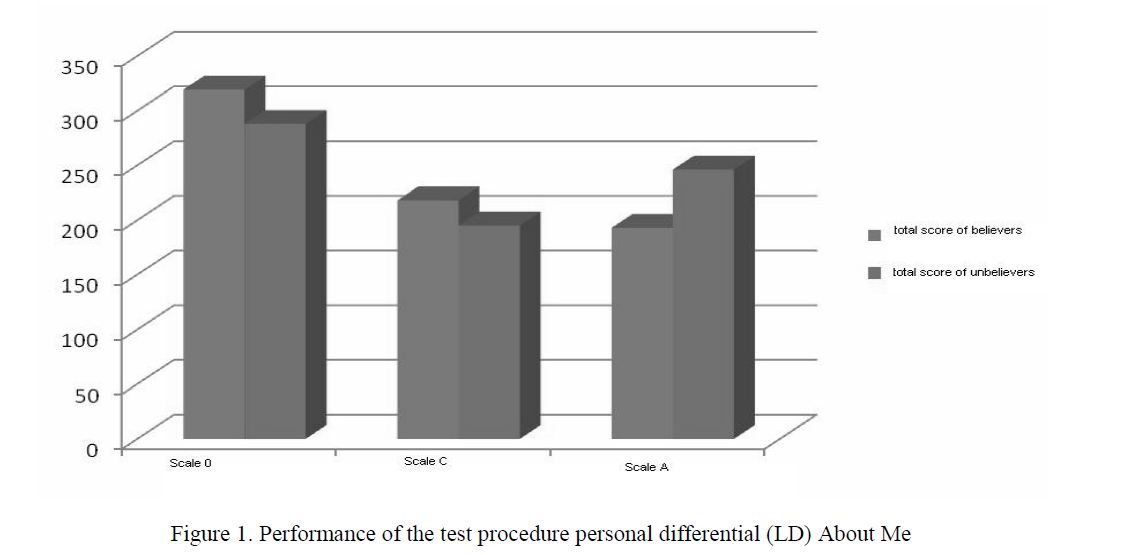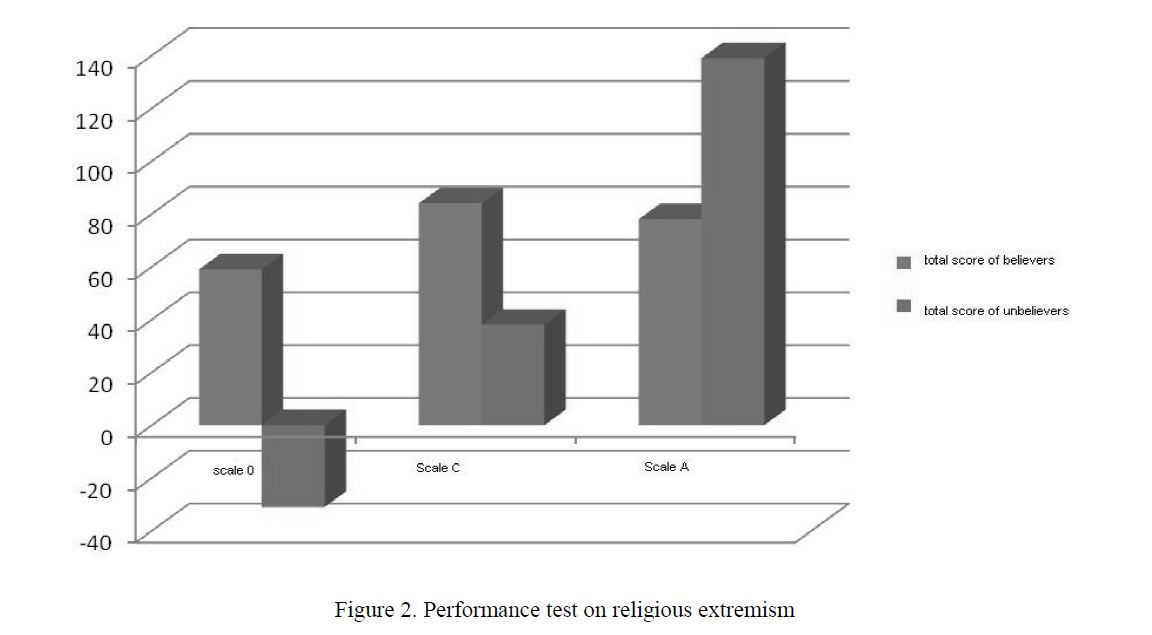The article deals with the problems of religious extremism. Key concepts: ‘religious extremist’, ‘religious extremism’, ‘belief’ and attitude of the people under test to these concepts. The research has been carried out to study the attitude of the youth to these concepts. The research results show that there is no difference in attitude to religious extremism between young believers and atheists.
The problem of religious extremism has become urgent in different sciences. This is connected to the alteration of people’s life — open borders, opportunity to migrate, availability of new technologies, people’s tolerance to each other irrespective of colour of skin and religious denomination. With the transition of people to a new lifestyle, change of gender roles and women’s independence, more and more people say it would be better for people to return to their traditional roles.
Scientific sources analysis shows that the basic feature of any manifestation of extremism is intolerant attitude to other people, religions, opinions, interests, etc. [1–3]. Unfortunately, extremism penetrates in many social spheres and institutions due to the development of modern technologies and opportunity to influence on people’s behaviour through social networks. This opportunity of extremism penetration is connected with the economic crises, corruption among politicians, decline of life level of a bigger part of population [4]. Therefore, people who are prone to the influence of religious extremists are a part of the population which belongs to vulnerable social layers or has marginal views.
Thus, the social basis of any manifestation of extremism, including religious, consists of the marginal social layers, including believers with radical views. The extremist sects can also influence socially vulnerable people who are dissatisfied with the economic situation in the country, acting political authorities, etc. The influence of religious extremists on the young people and their immature minds is especially great. Thus, the purpose of our research is to study the attitude of believers to religious extremism.
Sample of the people under test: 50 people: 25 believers and 25 atheists. Average age is between 18 and 25 years old. We have chosen the people who subjectively consider themselves to be believers. The people under test were the first, second and third-year students of Academician Y.A.Buketov Karaganda State University.
In order to study the attitude of the believers to the concept ‘religious extremism’ we have chosen the following methodological instruments: the personal differential methodology, the colour test of attitudes (CTA) by A.M.Etkind.
On the first stage of our research we carried out the personal differential methodology. The purpose was to define the attitude of the people under test to themselves and to religious extremism. Table 1 represents the results of the tested people’s personal differential (PD) according to three types of scales: assessment, strength, activity.
T a b l e 1
The results the people under test showed about themselves according to the personal differential methodology

The results of the research (Table 1) show that on the Scale Assessment the believers under test scored 319 points (12,76 %), the atheists under test scored 288 points (11,52 %). In two samples the obtained scores (319 and 288 points) are within norm, which means that the people’s attitude to themselves is good and they are satisfied with their behaviour, achievements, they identify themselves as personalities and do not have neurotic problems (fig. 1).

Figure 1. Performance of the test procedure personal differential (LD) About Me
On the Scale Strength the believers’ result is 218 points (12.76 %), the atheists’ — 195 points (7.8 %), which means that the people who subjectively consider themselves to be believers are more confident and independent. They try to rely on themselves in difficult situations.
On the Scale Activity we can assume that the atheists are more extroverted, active, sociable and impulsive. The believers scored a lower point — 193 (7.72 %), the atheists — 246 points (9.84 %).
Table 2 shows the data of the people under test about religious extremism and religious extremist.
The results of the personal differential methodology about religious extremist
T a b l e 2

On the Scale Assessment the believers scores 59 points (2.36 %), which means that they are satisfied with his behaviour, achievements and identify him as a personality. The atheists scored a negative point: -31 points (-1.24 %), which means that they do not accept an extremist as a personality and any his manifestations (Table 2).
On the Scale Strength the believers scored 84 points (3.36 %), which means that religious extremist is quite an ordinary person. The atheists scored 38 points (1.52 %), they consider religious extremist to be an unlawful person with insufficient self-control, he is unable to follow the accepted behaviour and dependent on the outside circumstances and assessments (fig. 2).

Figure 2. Performance test on religious extremism
On the Scale Activity the believers scored 78 scored (3.8 %), they defined religious extremism and a person involved into it as silent and calm, with good self-control. The atheists scored 139 points (5.56 %), which means they characterize religious extremist as an irritable and nervous person.
The research results according to the given methodology show that the attitude to religious extremist is different of people who subjectively consider themselves to be believers and the atheists.
On the second stage of the research we used the colour test of attitudes (CTA) by Etkind in order to find out the attitude of believers and atheists to the concepts ‘Religious extremism’, ‘Belief’, ‘I Myself’. The research results were analyzed with the help of frequency analysis. The frequency analysis CTO allows to find out what concept is more associated with a colour.
The frequency analysis of the believers under test showed the following results: Religious extremism — green (2), black (7); Belief — green (2), yellow (4), red (3); I myself — red (3), green (2), yellow (4), black (7). Thus, for the concept ‘Religious extremism’ the believers have chosen two colours: green (2), black (7). Green (2) is characterized by the confidence, active defense of personal view, persistence in goal achievement, efficiency, drive for self-expression, power and success, high level of assertions and strength of will. Black (7) shows that the believers subconsciously feel rejection, protest and non-existence.
For the concept ‘Belief’ 14 believers (56 %) have chosen green (2), which means the believers correlate the concept ‘Belief’ with the drive for self-expression, power and success, confidence, strength of will and tension. 7 people (28 %) have chosen yellow (4), which means the feeling of happiness, optimism, the hope for ease and freedom. 2 people (8 %) have chosen red (3), they correlate this concept with energy, excitement and initiative.
The concept ‘I Myself’ has the following colour associations: 8 people (32 %) have chosen red (3), which means that the people under test see themselves as leaders and active people, constantly showing initiative. They also need to act and waste their energy. Usually such people are aimed at success through struggle.
5 people (20 %) have chosen green (2), which means confidence, persistence in goal achievement, drive for self-expression, power and success.
5 people (20 %) have chosen yellow (4), it characterizes them as optimistic, happy, and relaxed people. 2 people (8 %) have chosen black (7), which means that these people feel rejection, abandonment, denial of themselves as personalities.
Thus, the results of the research of the colour test of attitudes (CTA) for the concept ‘I Myself’, firstly, show the variety of data. They also show that the people under test do not have a standard attitude to this concept. Secondly, it must be remembered that for the sample we chose the people who subjectively consider themselves as believers.
Next stage was an analysis of the empirical data of CTA of the atheists under test. In the result of the research the empirical data were as follows: Religious extremism — black (7), red (3), brown (6); Belief — yellow (4), green (3), red (3), blue (1); I Myself — yellow (4), blue (1), green (2), red (3).
Thus, the colour attitude to the concept Religious extremism is as follows: 8 people (32 %) have chosen black (7), which means that these people have a feeling of rejection, refusal and non-existence toward this concept. 6 people (24 %) have chosen red (3), it presumes that the people under test have an idea of a leader who is aimed at success through struggle and who needs to act and waste his/her energy. 4 people (16 %) have chosen brown (6), which shows sensory satisfaction, physical lightness and body comfort. 2 people (8 %) have chosen green (2), which they associate with insistence, tension, persistence in achieving their goals and active defense of their views.
Colour associations with the concept ‘Belief’ are as follows: 9 people (36 %) have chosen yellow (4), which means that the people under test associate the feeling of happiness, hope for ease and freedom with this colour. 6 people (24 %) have chosen green (2), they associate this colour with such ideas as vitality, persistence and confidence. 5 people (2 %) have chosen blue (1), which means peace, rest, emotional attachment, harmony and emotional stability. 3 people (12 %) have chosen red (3), these people associate it with leadership, initiative and excitement.
The colour associations of the people under test with the concept ‘I Myself’ are as follows: 6 people (24 %) have chosen yellow (4), which means optimism, perceptibility, relaxed personality. 5 people (20 %) have chosen blue (1), which means satisfaction, emotional stability, inner harmony. 5 people (20 %) have chosen green (2), which means that these people have a high level of assertion, they are active and efficient; they actively defend their views and try hard to achieve their goals. 4 people (16)% have chosen red, which characterizes them as personalities who possess the leader qualities, they are active, initiative and are aimed at success through struggle.
We can see that believers and atheists have the following attitudes to the concepts Religious extremism, Belief, I Myself:
- the choice of colours by believers under test for the concept Religious extremism — green (2), black (7), atheists — black (7), red (3), brown (6); the colour which coincides is black (7);
- the colour associations of the people under test with the concept Belief are as follows: believers — green (2), yellow (4), red (3); atheists — yellow (4), green (2), red (3), blue (1); the colours which coincide are green (2), yellow (4), and red (3);
- the people under test have the following associations with the concept I Myself: believers — red (3), green (2), yellow (4), black (7); atheists — yellow (4), blue (1), green (2), red (3); the colours which coincide are yellow (4), green (2) and red (3);
- both the believers and the atheists under test have an ambivalent attitude to the concepts Religious extremism, Belief, I myself, also there is a great variety of empirical data;
- the colour associations of the people under test with the concepts Religious extremism, Belief, I Myself are coincident in most
Consequently, according to the results of the search we can make the following conclusion: believers, despite the fact that their personal attitude to religious extremism is a little embellished, as well as atheists have a negative attitude to religious extremism, considering it to be dangerous and refusing to accept it.
References
- Kaluzhnaya N.A. Philosophic Sciences, Moscow, 2007, 9, p. 66–81.
- Inina N.V. Life in church, 1, 2013, p.
- Selivanov F.A. Search and correct erroneous, Tyumen, Publ: Socio-Psychological Center. 2003, p.
- James B. Varieties of Religious Experience, Moscow: Nauka, 2000, p. 115.